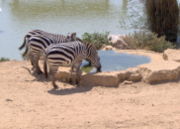Zebra
2007 Schools Wikipedia Selection. Related subjects: Mammals
| iZebras | ||||||||||||||
|---|---|---|---|---|---|---|---|---|---|---|---|---|---|---|
 |
||||||||||||||
| Scientific classification | ||||||||||||||
|
||||||||||||||
|
|
||||||||||||||
|
Equus zebra |
The Zebra is a part of the horse family, Equidae, native to central and southern Africa. They are most well known for their distinctive black and white stripes.
Stripes
They are white with black stripes. These stripes are typically vertical on the head, neck, forequarters, and main body, with horizontal stripes at the rear and on the legs of the animal. The zebra crossing is named after the zebra's white on black stripes.
Zoologists believe that the stripes act as a camouflage mechanism. This is accomplished in several ways. First, the vertical striping helps the zebra hide in grass. At first glance, this may seem absurd considering that grass is neither white nor black, but it makes sense because the zebra's main predator, the lion, is colour blind. A zebra standing still in tall grass may not be noticed at all by a lion. However, zebras are herd animals and do not usually travel alone, so the second way the stripes help in camouflage is by confusing the lion — a number of zebras standing or moving close together may appear as one large animal, making it more difficult for the lion to pick out any single zebra to attack.
Stripes are also believed to play a role in social interactions, with slight variations of the pattern allowing the animals to distinguish between individuals.
A more recent theory, supported by experiment, posits that the disruptive coloration is also an effective means of confusing the visual system of the blood-sucking tsetse fly. Alternative theories include that the stripes coincide with fat patterning beneath the skin, serving as a thermoregulatory mechanism for the zebra, and that wounds sustained disrupt the striping pattern to clearly indicate the fitness of the animal to potential mates.
Species
There are four extant species, as well as several subspecies. Zebra populations vary a great deal, and the relationships between and the taxonomic status of several of the subspecies are well known.
The Plains Zebra (Equus quagga, formerly Equus burchelli) is the most common, and has or had about twelve subspecies distributed across much of southern and eastern Africa. It, or particular subspecies of it, have also been known as the Common Zebra, the Dauw, Burchell's Zebra (actually the subspecies Equus quagga burchelli), and the Quagga (another extinct subspecies, Equus quagga quagga).
The Mountain Zebra (Equus zebra) of southwest Africa tends to have a sleek coat with a white belly and narrower stripes than the Plains Zebra. It has two subspecies and is classified as endangered.
Grevy's Zebra (Equus grevyi) is the largest type, with an erect mane, and a long, narrow head making it appear rather mule-like. It is an inhabitant of the semi-arid grasslands of Ethiopia, Somalia, and northern Kenya. The Grevy's Zebra is one of the rarest species of zebra around today, and is classified as endangered.
Although zebra species may have overlapping ranges, they do not interbreed. This held true even when the Quagga and Burchell's race of Plains Zebra shared the same area. According to Dorcas McClintock in "A Natural History Of Zebras," Grevy's zebra has 46 chromosomes; plains zebras have 44 chromosomes and mountain zebras have 32 chromosomes. In captivity, Plains Zebras have been crossed with mountain zebras. The hybrid foals lacked a dewlap and resembled the Plains Zebra apart from their larger ears and their hindquarters pattern. Attempts to breed a Grevy's zebra stallion to Mountain Zebra mares resulted in a high rate of abortion.
Zebra classification
- Plains Zebra, Equus quagga
- Quagga, Equus quagga quagga (extinct)
- Burchell's Zebra, Equus quagga burchellii
- Grant's Zebra, Equus quagga boehmi
- Selous' zebra, Equus quagga borensis
- Chapman's Zebra, Equus quagga chapmani
- Crawshay's Zebra, Equus quagga crawshayi
- Cape Mountain Zebra, Equus zebra
- Hartmann's Mountain Zebra, Equus hartmannae
- Grevy's Zebra, Equus grevyi
For the remaining species of the genus and family see Equidae.
Uses
Attempts have been made to train zebras for both riding and draft use, both for novelty value and due to their better resistance than horses to diseases in Africa. Although easily broken for both uses, they are highly strung and zebra-mules or zebroids (crosses between any species of zebra and a horse, pony, donkey or ass) are preferred over pure-bred zebras.
In England, Lord Rothschild frequently used zebras for drawing carriages. In 1907, Rosendo Ribeiro, the first doctor in Nairobi, Kenya, used a riding zebra for doing house-calls. Captain Horace Hayes, in "Points of the Horse" (circa 1899) compared the use of different zebra species.
Hayes saddled and bridled a Mountain Zebra in less than one hour, but was unable to give it a "mouth" during the two days it was in his possession. He noted that the zebra's neck was so stiff and strong that he was unable to bend it in any direction. Although he taught it to do what he wanted in a circus ring, when he took it outdoors he was unable to control it. He found the Burchell's Zebra easy to break in and considered it ideal for domestication as it was also immune to the tsetse fly bite. He considered the quagga well-suited to domestication due to being stronger, more docile and more horse-like than other zebras.

